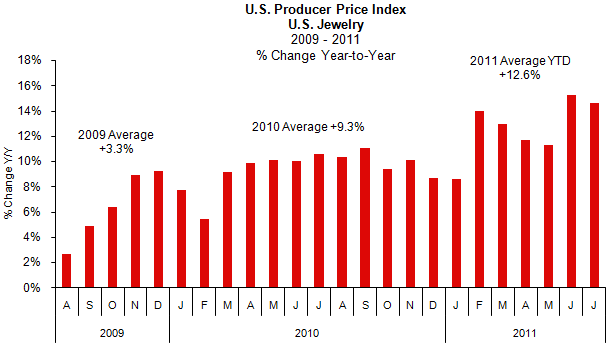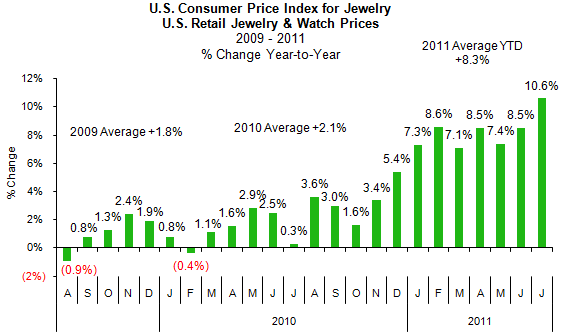IDEX Online Research: Jewelry Price Inflation Slips Slightly At Supplier Level in July
August 29, 11
(IDEX Online News) – While jewelry retail prices rose to record levels in July, supplier prices of jewelry slipped slightly from levels. However, both retail and supplier jewelry prices were up substantially over the same month last year, according to new government data.
The full analysis is available to IDEX Online Research subscribers and IDEX Online members here.
· Retail prices of jewelry jumped by 10.6 percent in July versus the same month a year ago. This was the second largest monthly year-to-year increase in jewelry price inflation since the current JCPI (Jewelry Consumer Price Index) database began in 1987. In part, July’s high inflation rate was due to a deflationary price trend which occurred in July 2010; as a result, the percentage change year-to-year was large in July.
· Suppliers’ prices for jewelry soared by 14.6 percent over the same month a year ago, one of the largest increases since we began keeping jewelry inflation statistics in 1980, more than 30 years ago. This large gain was driven almost entirely by rising prices for gold and precious metal jewelry. However, when compared to June 2011 prices, the JPPI (Jewelry Producer Price Index) slipped slightly.
July’s record inflation levels year-over-year come after a moderation in the inflation rate in April and May, followed by a surge in June.
Supplier Price Inflation Up Double-Digit Levels in July
After decelerating from February through May, the Jewelry Producer Price Inflation trend jumped in June and July on a year-over-year basis, as the graph below illustrates. For the seven months year-to-date through July, suppliers’ prices of jewelry have risen by 12.6 percent. This is well above the average annual rate for both 2009 and 2010, as shown on the graph.
It is noteworthy that, while the JPPI is still posting double-digit gains, the year-to-year rate of inflation moderated slightly in July. Despite surging prices for jewelry commodities – gold, silver, diamonds, and other precious gemstones and metals used in jewelry manufacturing – it appears that jewelry suppliers simply did not pass along all of those costs. Further, we are aware of retailer “push-back” of some of those high supplier prices. Of course, it could also be simply an anomaly in the data that will correct itself over the next few months.
The graph below summarizes trends in both the Jewelry Producer Price Index (JPPI) which tracks jewelry price inflation among jewelry suppliers and manufacturers.
 Source: BLS |
Retail Jewelry Price Inflation Soars in July
The graph below summarizes jewelry price inflation at the retail level in the U.S. market. These statistics reflect the typical retail prices of jewelry this year versus last year.
 Source: BLS |
Why High Inflation?
Two key factors are driving unusually high jewelry price inflation in both the U.S. market and the global market during the month of July 2011:
· Higher precious metals prices, especially gold – Average gold prices in July were up 32 percent over the prior year, platinum prices climbed by 15 percent, and prices of silver soared by 111 percent.
· Higher polished diamond prices – Polished diamond prices rose by 25 percent over the prior year, according to the IDEX Online Global Polished Diamond Price Index.
Outlook: Inflation Likely To Remain Relatively High
As long as consumer demand remains relatively robust, both in existing markets in the U.S. and Europe, as well as new emerging markets in Asia and India, we expect to see higher prices for precious metals and gemstones. Further, there is some temporary inflation coming from higher gold prices as people move into gold as a hedge against volatile financial markets and weak currencies.
The full analysis and statistics on jewelry industry inflation in July is available to IDEX Online Research subscribers and IDEX Online members here. Click here for more information on how to subscribe or become a member.